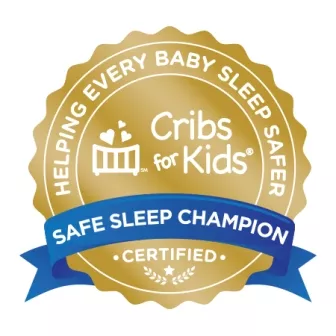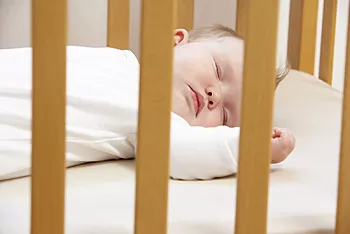Safe sleep
Sudden Infant Death Syndrome (SIDS) is the leading cause of death for babies up to 1 year of age in the United States.
The American Academy of Pediatrics (AAP) Task Force on SIDS has national guidelines to lower the risk of SIDS and other sleep-related deaths, such as accidental suffocation. The SIDS task force at Stead Family Children’s Hospital supports the AAP guidelines as the safest sleep environment for babies.

Safe sleep for your baby
Sudden Infant Death Syndrome (SIDS) is the leading cause of death for infants in the United States up to 1 year of age. In 2022, the American Academy of Pediatrics (AAP) Task Force on SIDS updated their national guidelines to reduce the risk of SIDS and other sleep-related deaths. The SIDS task force at Stead Family Children’s Hospital supports AAP guidelines as best practice for creating the safest sleep environment for infants. Take the following steps to reduce your baby’s risk for SIDS and other causes for sleep-related infant death, such as accidental suffocation:
- Always lay your baby on their back for sleep, at naps and at night.
- Baby should sleep in a safety-approved crib, bassinet, or pack-n-play covered with a fitted sheet.
- Do not place any soft objects, including pillows, blankets or bumper pads, in baby’s sleep area.
- Dress your baby in a sleeper or sleep sack for comfort and warmth during sleep.
- Weighted blankets, sleepers or swaddles should never be placed on or near sleeping infants
- Infants should never be placed for sleep on a couch, sofa, armchair or similar cushioned surfaces.
- Keep baby’s crib in your bedroom, close to your bed ideally for the first 6 months after birth.
- Don’t smoke cigarettes or marijuana during pregnancy or after birth. Don’t allow anyone else to smoke around your baby.
- Feed your baby breast milk for at least the first 2 months and longer if you so desire.
- Give your baby a pacifier for naps and at bedtime.
- Do not let your baby get too hot during sleep.
- Your baby should receive routine vaccinations and regular health checkups.
- Tummy time is important, but only when baby is awake and you are watching closely.

Learn more about ways to reduce the risk of SIDS and other sleep related causes of infant death
Not all safe sleep products are safe for infants
Many products are marketed for “safer sleep” or to reduce the risk of SIDS. However, products without the endorsement of the AAP have not been shown to be safe for infants and are not recommended.
Products for which the AAP remains neutral:
- Special crib mattresses: Some manufacturers claim that certain mattresses aid in the dispersion of carbon dioxide in situations where an infant rolls onto their tummy while sleeping. The AAP asserts there is no data to support this claim, however there is no harm in using CSPC-approved crib mattresses as long as safe sleep practices are maintained.
- Monitoring devices: There is no evidence that home cardiorespiratory monitors decrease the incidence of SIDS. Parents who use home cardiorespiratory monitors and other wearable wellness devices should still follow safe sleep recommendations.
Products and practices considered unsafe by the AAP:
- Weighted sleep products: The AAP does not recommend any weighted objects to be placed on or near sleeping infants. This includes weighted blankets, weighted sleepers and weighted sleep sacks.
- Wedges/positioners: The AAP strongly recommends placing infants on their backs to sleep on a firm, flat surface. Side sleeping and positioning is not advised. Wedges and other positioning devices are not recommended by the AAP.
- Bumper pads: Bumper pads and mesh bumpers have been implicated as factors contributing to infant deaths from suffocation, entrapment, and strangulation. Padded crib bumpers are now banned in the US under federal law.
- The following products do not meet federal safety standards for cribs, bassinets, play yards (pack-n-play) or bedside sleepers, and they are not recommended: inclined sleep products, cardboard baby boxes, in-bed sleepers, baby nests and pods, and hammocks.
- Bed sharing/co-sleeping: Infants should sleep in the parents’ room, close to the parents’ bed but on a separate surface designed for infants, ideally for at least the first 6 months.
Approved safe sleep products can be purchased from the Stead Family Children’s Hospital Safety Store. The trained Safety Store staff is also available to provide education on how to use safety products.
Remember tummy time
Put a thin blanket on a clean floor. When baby is awake and someone is watching, place baby on his or her stomach.
Tummy time is important because it:
- Helps prevent flat spots on back of baby’s head
- Makes neck and shoulder muscles strong so baby can start to sit up, crawl, and walk. Develops coordination and motor skills.
- Helps baby learn to play and interact with his or her surroundings
Blankets are for tummy time, NOT FOR SLEEP.
Safe sleep Facebook LIVE
The safe sleep experts at Stead Family Children's Hospital answer viewers' questions during Facebook LIVE sessions.
Published on
- Safe Sleep Products - Nov. 26, 2018 (video 32:17 mins.)
- Safe Sleep - Feb. 1, 2018 (video 30 mins.)
Safety Store
Safe sleep products can be purchased from the Stead Family Children’s Hospital Safety Store. The trained Safety Store staff is also available to provide education on how to use safety products. For more information, visit https://uihc.org/childrens/locations/safety-store.